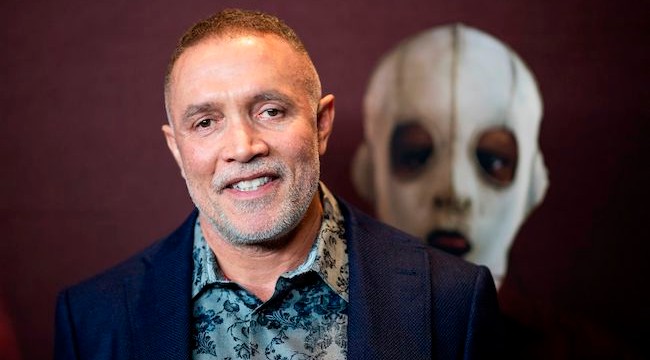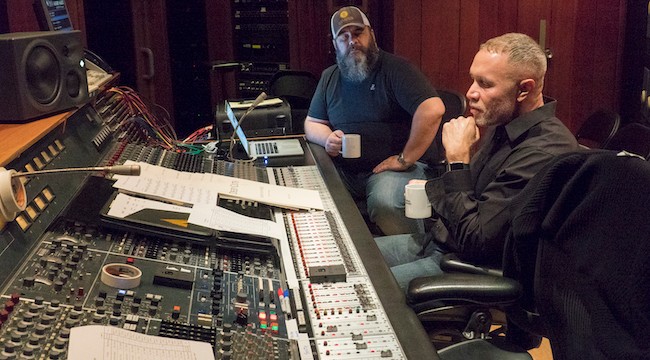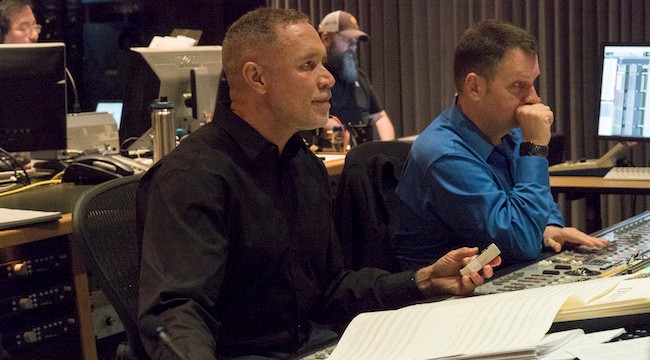
Jordan Peele’s smash hit Us is dominating the box office and sparking a lot of discussion due to the idea that everyone sees its intent and purpose differently. While Peele’s first movie, Get Out, was more cut-and-dry in the message being portrayed on screen, this one has definitely been left up to interpretation. One of the constants in both movies, however, is the symbolism inherent in pairing well-known songs with foreshadowing scenes, and the kind of flawless musical direction that turns typically elating songs into soundtracks fit for a horror movie.
Michael Abels, the musical composer of Us, is the kind of creative force who can find the intersection between culture and emotion by using notes and sounds. Just by adding a space in between two instruments, he has the power to evoke fear from a song that was originally geared around rolling one up with your people. He created the musical compositions for Us that also bring the duality of the story into sharp perspective. Abels said that even when he’s crafting music, he always has the idea of storytelling at the forefront of his mind.
“I look at composing [and] writing music as storytelling, regardless of the medium,” Abels said when we discussed his process recently over the phone. “You’re trying to take listeners on some kind of journey, and it’s also very much a pure emotional expression. There’s some specific emotion that I’m expressing and that I’m trying to have others feel in their own way. So, in that sense, writing for film was natural for me.”
Being able to use music as an escape or release is something very special for Abels. The movie sets the scene of a middle-class family taking a vacation to one of Santa Cruz’s beautiful beaches. While it seems great on the surface, lead character Adelaide, portrayed Lupita Nyong’o, is facing her inner demons by returning to a once-traumatic experience where she encountered a living, breathing mirror version of herself as a child. The horror of a break-in by her family’s evil counterparts and the resulting quest for vengeance by the evil family sets up the plot for Abels to create his soundtrack.
“A lot of the emotions that the characters are expressing on the screen are not ones I’d choose to have in my regular life,” he explained. “But it’s really nice to be able to have an excuse to be able to express those emotions of terror and despair and things that we all face, but we’d rather have them be in a much more manageable, safe environment like a movie theater.”
Abels had the tough task of conveying mostly-unknown levels of terror, horror, and hopelessness and finding a juxtaposition with the main characters’ “tethered” counterparts. In one respect, half of the characters are going through the most traumatic experience of their life, one in which they face their own mortality while questioning their own sanity. The other set of characters, neglected mirror images only attached by body, are in the midst of the most hopeful and vivacious moment of their lives. Creating this duality was something unique and, while a bit of a challenge, it created an opportunity for something new and different as inspired by director and film writer Jordan Peele.
“Jordan had me read the script before he had shot any of the film,” Abels recalled. “This was a similar process to Get Out in that respect. Then, he is very conscious of the power of music and film, and particularly in suspense and horror. So, he’ll tell me the type of music that he’s thinking of, and, in the case of Us, he said, ‘Clearly, the whole story is about duality in both the mirror image and yet the alternate image, so why don’t you try experimenting with some sounds that don’t go together, a couple of deliberately unconventional choices, and see what happens.’ I did that and I came up with some demos, some examples of me just experimenting with things that I wouldn’t have otherwise experimented with if he hadn’t told me to go and play in that sandbox.”
The results of that experimentation can be heard on tracks such as the film’s main title song “Anthem.” In the song, you hear not only a terrifying, thrilling build-up track, which uses a melodic marching beat, but also offers the haunting voice of children harmonizing. Peele and Abels’ inspiration plays off of the duality of something as sweet and innocent as children mixed with the horror and petrifying sound their arrival brought in the film.
https://www.youtube.com/watch?v=sAPMW2fu3m0
Abels described this process of creating the soundtrack as one that looked to shed light on the unusual without being overbearing; he likened it to hearing a sound outside your house, in the sense that you could hear the same five sounds on a daily or weekly basis from outside, but the one time something sounds even a little different, it sticks out in your head and creates a cause for concern.
“When you’re trying to make people feel afraid or nervous, or have anxiety, using sounds is the primary way that you can accomplish that,” Abels explained. “When we hear something just outside our houses, let’s say, we don’t know what it is, we’re instantly drawn to, ‘What was that?’ So, musically I’m doing the same thing, I’m trying to find music that is something that is a little undefinable that’s gonna make you pay attention in that way that you do when your senses are heightened.”
Creating new sounds was a welcome challenge for the composer. Abels went into specifics on Adelaide’s character and her diabolical counterpart, Red, and how he treated the task of making them stand out in their own ways, respectively. Different characters had unique tones that would differentiate them from another, sounds created by the combination of unusually-paired instruments.
“It’s not as simple as, now you see Adelaide, and now you hear her singing,” Abels said. “There’s a little going on, there’s a solo violin. To me, it represents Red’s malevolent spirit and her quest for justice. You’ll hear very angular solo violin lines at times when she’s on screen.”
For Zora, Adelaide’s daughter, played by Shahadi Wright Joseph, the sound of a piano being hit by a hammer, a truly unorthodox sound for a movie score, is repeated numerous times. Umbrae, Zora’s tethered version, spends a large portion of the movie hauntingly smiling while quite literally chasing down and hunting Zora as if killing her were a track event. Overall, the entire world created for the tethered, a series of tunnels, was meant to have its own feel, something that felt dark and eclectic.
“[In] the tethered world, there’s really a lot of sounds in the score that kind of almost range into the world of sound design,” Abels said. “Meaning that if you just heard the sound itself, you wouldn’t be sure if it was music or if it was an ambient sound. There [are] these ominous low, lonely rumbling sounds and things, and those are in there to help create the world of the Underpass where the tethered live. When we finally see that world, it needs to feel like we’re in a very lonely, empty cavern, so I really wanted to make sure that the musical world matched the setting that we were seeing on the screen.”

When creating the score for a movie, decisions about how to create the film’s world are incredibly difficult and always-changing; they can change based on the length of a scene, they can change on the tone, they can even change based on something that happens later in the movie that has a butterfly effect on earlier scenes serving as foreshadowing elements. The decision to use Luniz’s “I Got 5 On It” is absolutely something that was intended from the start but wasn’t necessarily written into the scene’s powerful pinnacle dance battle until feedback from the trailer came.
“Originally in the film, the final battle, the dance fight that happens was going to go be set to Tchaikovsky’s “Pas De Deux” from the Nutcracker,” Abels said. “Which is still actually in the end of the film, but just only for a few seconds. But, with all the reaction that people had with the trailer, I think Jordan, he’s really good about responding to feedback, he really wants an audience. He doesn’t mind taking your experience and twisting it.”
Taking something as beautiful and elegant as the Nutcracker’s “Pas De Deux” and turning it into a cold, terrorizing dance is an occasion all its own. But, adding another layer through a classic hip-hop song — created by two rappers from Oakland who set it forth as an anthem in their local scene — is an even bigger feat, one that incorporates a myriad of cultures not only for the viewers of the movie but also for fans of hip-hop culture, something revolutionary in the horror genre. “I Got 5 On It” heavily sampled the beat from Club Nouveau’s 1986 hit “Why You Treat Me So Bad” and has been credited as a sample by artists such as Yo Gotti, Diddy, Meek Mill, Big Sean, and about fifty other artists as a lead sample for their songs. But Peele wanted to have his own version of the track for use in Us.
“He knew that he had to make good on that incredible promise of “I Got 5 On It” in the film,” Abels said of Peele’s decision to switch out “Pas De Deux” for an orchestrated version of the hip-hop classic. “That’s when we took that scene and decided, ‘Let’s do the “I Got 5 On It” climax and see what that looks like.’ The minute he heard the version with the string orchestra that starts when Red and Adelaide begin dancing their faces off, his eyes just lit up and he said, ‘Oh, this is going to work.’”
As duality has been a constant theme throughout this movie and in Abels’ process, it’s only fitting that a scene portraying a side of black women that is rarely shown in Hollywood creates its own two-sided reality, not only for black viewers but also for Adelaide. Showing where she came from and the different sides to her character aren’t meant to portray that she has a foot in two different cultures but, rather, that both sides are part of one culture for her.
There have been very few films to date that portray an upper-middle class Black family and even fewer that display a character such as Adelaide who, in one scene, snaps along arhythmically to “I Got 5 On It” (as part of her culture), and then, in another scene, elegantly dances and ends in a classic ballet pose to the same song as just another version of her culture that’s still part of what makes up her person. The history of the original song proves this point as well — cultures extend far beyond what’s most often portrayed at their forefront. The song itself is arguably a mash-up of different facets of Black culture. While “I Got 5 On It” producer Tone Capone obviously loved hip-hop, he clearly had an appreciation for Club Nouveau’s impact on R&B and New Jack Swing as well.
Adelaide’s character achieves a similar feat, reaching conclusions that can’t be classified down to race, color, or stereotypes of an individual. Her culture is her own, which is demonstrated by the different beat-riding reactions she has to two versions of the same song. To take something like ballet that is rarely (especially in Hollywood) portrayed as an activity for Black girls, and create a juxtaposition with hip-hop and something special to the character’s own backstory is another way to break barriers and knock down segregated walls.

“They’re Black, but they don’t need to be Black for this story to work,” Abels asserted. “This story is not about race on its surface, but some of the cultural touchstones in it are things that might be unique to their experience. But, they’re treated as if this is just part of the middle-class American experience. It’s really crucial that people of all backgrounds be able to see us having our lives and being a central part of the culture, rather than an extra, or additional or exotic part of it.”
Making the characters relatable and normal is a huge part of the premise for Us. This family can be relatable to families across the country by playing on themes of the dorky dad, teenage daughter, curious son, and a strong mother. That was a large portion of getting everything right, rather than watching the movie and seeing race, it was more about normalizing race and eliminating the stereotypes that often come with it.
“With Get Out, it stars a young, Black American, and it was crucial that anybody who watches the film be able to see it through his eyes, and he’s having this experience that’s clearly based on race,” Abels said. “But, with Us, you’re also asking them to see it through the eyes of a Black family, but it’s not about their race, you’re just expected to be able to relate to them purely as who they are, and see yourself in them. What we’re talking about here, none of it’s spelled out in the film — but that actual impact and that expectation of the audience, I think it’s unprecedented and it’s really important.”
TheUs soundtrack is now available on all major platforms for streaming and purchase.






